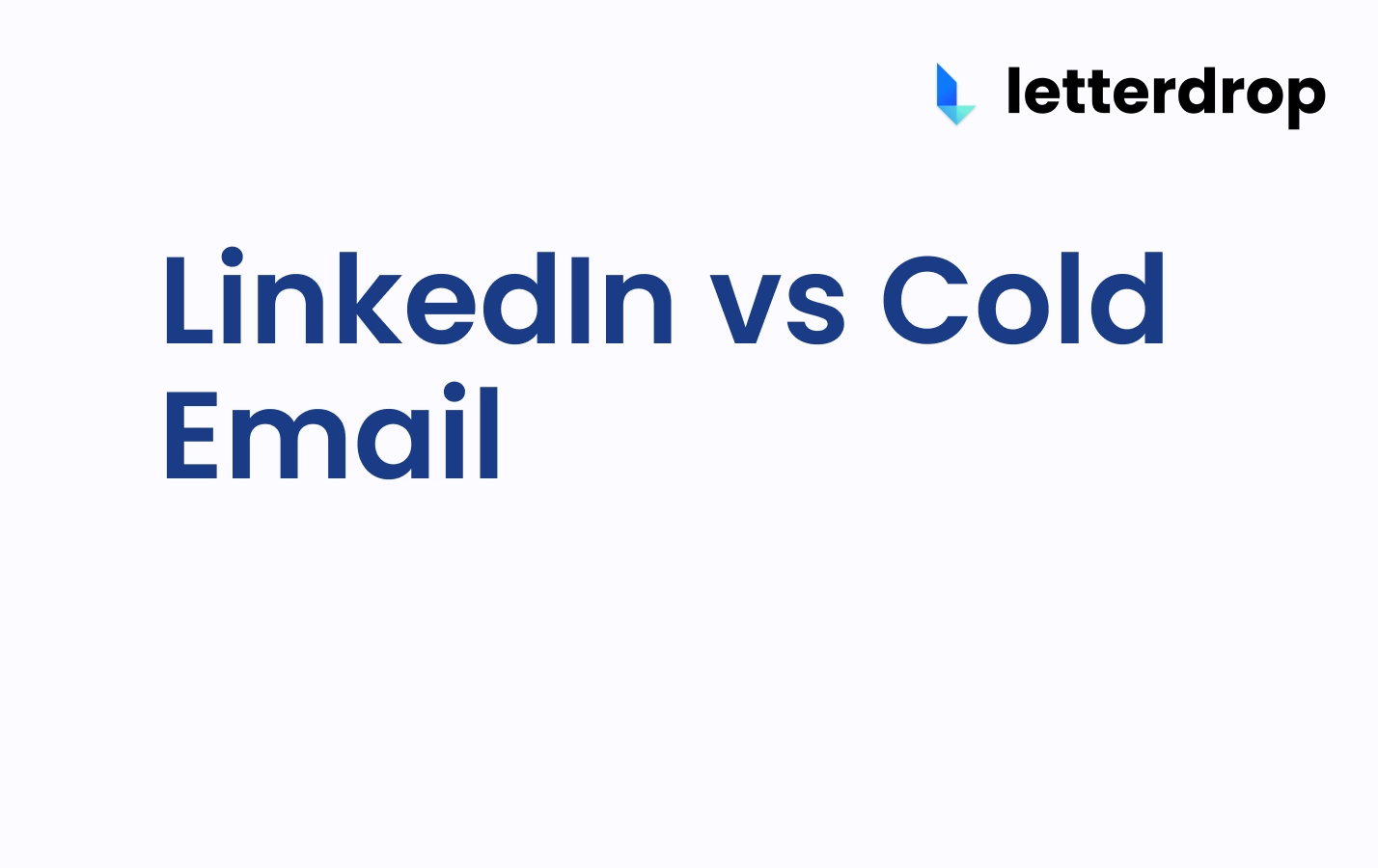LinkedIn Social Selling: A Crash Course
Before you read — we condensed two years of success on LinkedIn into a two hour social selling course.
(You can get it for free if you just reach out to sales@letterdrop.com first or get your manager to).
Check it out.
Social selling isn’t a gimmick — it works. The only time it doesn’t generate pipeline is when your buyers simply aren’t online.
For B2B sales, LinkedIn is the best place to engage with decision-makers.
If you’ve ever booked a meeting from a LinkedIn DM or seen your company drive pipeline through LinkedIn ads, you already know there’s opportunity here.
But social selling isn’t for everyone. It’s most effective when:
- You sell to buyers with longer, relationship-driven sales cycles
- You need to break into new accounts or industries
- You want to build authority and nurture demand over time
It’s not direct response. If cold calls and emails are filling your pipeline, keep doing what works. But if you want to generate inbound interest and make outbound easier, social selling is a skill worth developing.
How to Master Social Selling on LinkedIn
Step 1 — Workshop Your LinkedIn Profile
We have a separate guide on best practices for your LinkedIn profile, but here's the gist.
Your LinkedIn profile is a sales asset, not a resume. Approximately 82% of buyers look at your online profiles first before contacting you.
You need to treat it like a landing page that will make your target buyers want to connect with, follow, and respond to you.
Key areas to improve:
- Headline & About Section – Position yourself as a problem-solver, not just a job title. Your profile should invite connection, not look like a sales pitch.
- Profile & Banner Images – First impressions matter; make sure they align with your brand.
- Experience & Featured Section – Showcase credibility with relevant content and insights.
Here's an example of how we live-edited Kasey Devine's profile together.
Step 2: Finding and Prioritizing the Right Buyers
Not every company is ready to buy — only a small percentage of your market is in play at any given time. Social selling is most effective when you focus on the right accounts and prioritize outreach based on real buying signals.
Step 2.1: Identifying Best-Fit Accounts
Before you start prospecting, you need to be sure you're targeting companies that actually make sense.
The best way to do this? Look at your existing top customers. What do they have in common? What made them convert quickly?
Once you have a profile, you can use tools like LinkedIn Sales Navigator to find similar companies and key decision-makers.
More advanced prospectors use data enrichment tools like Clay to dig deeper, scoring and prioritizing accounts based on specific criteria.
Step 2.2: Spotting In-Market Buyers
Even within your ideal accounts, not everyone is actively looking for a solution.
The key is identifying those who are already signaling interest — whether that’s through website activity, competitor research, LinkedIn engagement, or hiring trends.
The right tools can surface these signals, but knowing how to interpret them is just as important. Instead of wasting time on broad outreach, you want to focus on the people already raising their hands.

Step 3: Making the Most of LinkedIn Connections
Connecting with someone on LinkedIn unlocks two key advantages:
- They start following you → 80% of LinkedIn’s weekly active users read their feed, meaning your content can nurture them over time.
- You can DM them → Unlike emails, LinkedIn DMs have far less competition and a much higher chance of being opened.
Maximize Your Network
You can send ~100 connection requests per week (closer to 150 with a paid account).
At a 20% acceptance rate, that’s 1,000+ new prospects per year that you can message and influence.
A strong LinkedIn profile is the biggest factor in getting accepted — your first impression matters.
Best Practices for Connection Requests
- Send a blank request unless you’ve met them before or have a mutual connection.
- If adding a message, keep it light and personal — absolutely no pitching.
- Engage before connecting—commenting on their posts can increase acceptance rates.

And if a request isn’t accepted in 1-2 weeks, withdraw it. Too many outstanding requests signals to LinkedIn that you’re spamming. You can always try again later.
Step 4: Finding Warm Leads on LinkedIn
LinkedIn activity gives you valuable clues about who might be open to a conversation. Here’s how to spot them and what to do next.
Engagement on Your Posts
- Likes or comments → Open the conversation: “Saw that you’re thinking about [topic]. How have you been dealing with [related problem]? [Case study] solved it by [solution].”
- New company followers → “Saw you might be exploring [category]. Using anything today? I know a thing or two about [problem].”
There's more that we cover in the course, but you get the idea.
Proactively Finding Prospects
If your inbound engagement is low, search for relevant conversations:
- People frustrated with competitors → Search for “[competitor name]” + keywords like bad, issue, problem, slow, not working, alternative.
- People talking about your company → Search for your company name and join the conversation.
Competitor Engagement
Your competitor’s followers and post engagers are potential leads. If they seem like a customer:
- “Saw you might be using [competitor]. They’re great for [X], but you seem like you’re in [Y]. How’s that working for you?”
If they’re just exploring the topic:
- “Saw you’re thinking about [topic]. How have you been dealing with [problem]? [Case study] solved it with [solution].”
Step 5: DM Properly
We go into this into a lot more depth in the course and include a bunch of templates — you can also read more about booking more meetings via LinkedIn DMs here.
Unlike email, where inboxes are flooded, LinkedIn limits who can message your prospects.
If you've engaged with their posts or comments before reaching out, your chances of getting a response are even higher.
InMails, on the other hand, feel like ads. If you have to pay to reach someone, it signals a pitch, and most people instinctively tune out.
To see how many buyers you can DM today (also known as your total messageable market, a subset of total addressable market), open Sales Navigator.
Filter by your ideal customer profile — industry, job title, company size, location—and switch to First-Degree Connections. This is your real reach, the number of prospects you can message right now.
The bigger this list, the better.
Common Mistakes That Kill Response Rates
Most sellers get DMs wrong.
- They connect and immediately pitch.
- They send walls of text — defeats the purpose of the channel, which faciliates short, snappy messages (almost like texts.)
- They send links. This feels transactional and suspicious.
What Makes a Good DM?
A strong DM is short, casual, and easy to reply to. There’s no need for formal greetings—just get to the point.
If someone follows you for example, a simple, “Thanks for the follow, John! Anything I post recently catch your eye?” opens the door for conversation.
Using video and voice notes in your DMs feels personal and show effort, making them stand out. But they only work if they’re truly personalized. AI-generated videos or generic recordings erode trust.
If you send a video, keep it under a minute. Add a short text preview—“Quick 1-min video for you re: [topic]”—so they know it’s brief.

Done right, LinkedIn DMs aren’t just another channel—they’re the closest thing to texting a decision-maker’s phone.
Step 6: Multithread
Most deals involve more than just your champion — there’s a buying committee, other stakeholders, and decision-makers who can make or break the sale.
Typically, you'd rely on your boss to follow up with a higher-up, but their email might go unread. You need a better way to get in front of the right people.
Use LinkedIn. Ask your champion who else is involved, then send those stakeholders a connection request:
"Been speaking with John about the cost optimization project. He mentioned this would be relevant to you."
This is one of the rare times a connection note makes sense. With a mutual touchpoint, your acceptance rate should be 50%+.
Now, when your champion brings you up internally, stakeholders already recognize your name. Your deal won’t get killed in a 30-second chat.
Step 7: Comments
Commenting on LinkedIn is a powerful, non-aggressive way to get in front of your prospects.
Not all of them will be posting regularly, but between 1-10% of your target audience is posting each month, creating an excellent opportunity to increase visibility without pitching.

Good Comments
Good comments extend the conversation and add value. They show genuine interest and engage with the prospect's post thoughtfully. For example, if a prospect posts that they're hiring:
- "Commenting for reach + sharing with my network. I actually have an old coworker who would be a great fit. Sending this her way."
After leaving a valuable comment, you can follow up by sending a connection request. If the timing is right, continue the conversation in DMs, but remember — avoid pitching immediately. Your goal is to build a relationship first.
Bad Comments
Bad comments don’t add value and can harm your credibility. Avoid generic, AI-generated comments or ones that don’t contribute to the discussion, like "great post" or "in today's digital world...".
A comment should always be thoughtful and relevant. It’s not about simply getting in front of them—it’s about engaging meaningfully.
To help you maximize your commenting strategy, you can monitor accounts to find commenting opportunities and track how many you have each month using Sales Navigator. This is covered in more detail in the full course.

Step 8: Post to Stay Top of Mind
As an AE, it's easy to go a week without contact, but your prospect isn’t thinking about you all day.
Stay active by posting helpful content and comment on your champion's posts. This makes it harder for them to forget you and can even restart deals.
Only 21% of decision-makers pick up the phone. The average exec gets 120 cold emails a day. Your outreach is drowning in noise.
For just 15-30 minutes a week, posting on LinkedIn builds familiarity, trust, and even inbound leads. Prospects recognize your name, open your emails, and are more likely to engage.
What to post?
- Answer common prospect questions
- Share quick industry insights
- Give takes on trends
- Show product demos
What to avoid?
- Reposting company content without adding value
- Fluff your buyers don’t care about
How often? 2-3x per week. Posts have a 48-hour shelf life—just get started and stay consistent.
Step 9: Tracking Results and ROI
In the long run, only one metric matters: Closed/Won revenue. But since that takes time, here’s what to track in the meantime:
- Connections & Followers → Are potential buyers following you, engaging, and resurfacing in deals?
- Meetings → Are you booking more, and with the right people? Are stalled deals reviving?
- Inbound Interest → Are buyers reaching out because they saw your content?
How to track?
- Add “How did you hear about us?” to demo forms.
- Use UTM links to track clicks from your LinkedIn profile.
If you’re posting but not booking meetings:
- Your content is attracting salespeople, not buyers → Connect with more prospects.
- Your connection requests aren’t being accepted → Your profile might look too salesy.
- Your DMs aren’t getting responses → Your messaging is too pushy or off-target.
If your buyers aren’t on LinkedIn, don’t force it. Take the same playbook to where they are.
(And get your hands on the full course below.)
Subscribe to newsletter
No-BS GTM strategies to build more pipeline in your inbox every week
Related Reading
Some other posts you might find helpful
















